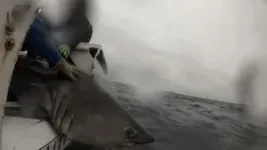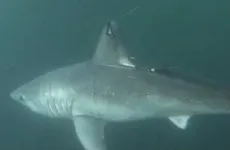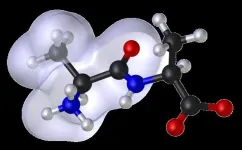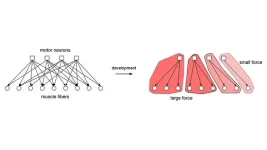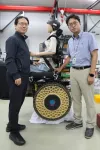(Press-News.org) Who killed the pregnant porbeagle?
In a marine science version of the game Cluedo, researchers from the US have now accused a larger shark, with its deciduous triangular teeth, in the open sea southwest of Bermuda. This scientific whodunnit is published in Frontiers in Marine Science.
“This is the first documented predation event of a porbeagle shark anywhere in the world,” said lead author Dr Brooke Anderson, a former graduate student at Arizona State University.
“In one event, the population not only lost a reproductive female that could contribute to population growth, but it also lost all her developing babies. If predation is more widespread than previously thought, there could be major impacts for the porbeagle shark population that is already suffering due to historic overfishing.”
Porbeagles are sharks from the Atlantic and South Pacific Ocean and the Mediterranean. They are large, active, powerfully built – up to 3.7 meters long and weighing up to 230kg – and long-lived, living up to 30 or even 65 years. Females don’t reproduce until they are about 13 years old, and then give birth to an average of four pups every one or two years, born live after a gestation period between eight and nine months.
Because of their slow reproductive cycle, porbeagle populations cannot recover quickly from persecution, recreational fishing, bycatch, and habitat loss and degradation to which they currently are exposed. Indeed, Northwest Atlantic porbeagles are listed as endangered on the IUCN Red List of Threatened Species, while the Northeast Atlantic and Mediterranean populations are critically endangered.
Scientific game of tags
As part of their research into shark migration, Anderson and colleagues captured porbeagles off Cape Cod in Massachusetts in 2020 and 2022. Each porbeagle was equipped with two satellite tags, a fin-mount satellite transmitter and a pop-off satellite archival tag (PSAT), before being released. Fin-mount tags send the current location to satellites whenever the shark’s fin rises above the surface. PSATs continuously measure depth and temperature and store these data until the tag falls off, typically after a predetermined period, after which they float to the surface and transmit their stored data to satellites.
Among the tagged porbeagles was a pregnant female, 2.2 meters long. Anderson et al. hoped to obtain data from this female to help identify important habitats for porbeagle mothers and their newborns.
But fate intervened. Unexpectedly, this female’s PSAT started to transmit off Bermuda 158 days after its release. This implied that the PSAT had popped off and was now floating at the surface.
Data then transmitted showed that this female had been cruising for five months at a depth between 100 and 200 meters at night and between 600 and 800 meters during the day, in waters with a temperature between 6.4 and 23.5 °C. During this time, the fin-mount tag had transmitted only once, confirming that she remained underwater most of the time.
But suddenly, from 24 March 2021 onwards over the period pf four days, the temperature as measured by the PSAT remained at an approximately constant 22 °C, at a depth between 150 and 600 meters. Only one explanation was possible: that day, the unfortunate porbeagle had been hunted and eaten by a larger predator. The PSAT must then have been excreted about four days later, starting to transmit.
Two suspects
“Two endothermic predator candidates large enough to predate upon mature porbeagles and located within the vicinity and at the time of year of the predation event include the white shark Carcharodon carcharias and shortfin mako Isurus oxyrhinchus,” wrote the authors.
Shortfin mako sharks are known to feed on cephalopods, bony fish, small sharks, porpoises, sea turtles, and seabirds, while great whites also feast on whales, dolphins, seals, and rays. Of the two candidates, a great white shark was the more likely culprit, as shortfin mako typically make rapid oscillatory dives between the sea surface and deeper depths during the day while in the open ocean – a behavior not registered by the PSAT.
“The predation of one of our pregnant porbeagles was an unexpected discovery. We often think of large sharks as being apex predators. But with technological advancements, we have started to discover that large predator interactions could be even more complex than previously thought,” said Anderson.
“We need to continue studying predator interactions, to estimate how often large sharks hunt each other. This will help us uncover what cascading impacts these interactions could have on the ecosystem.”
END
Large sharks may be hunting each other – and scientists know because of a swallowed tracking tag
In a scientific whodunnit, researchers have discovered the first known case of a large porbeagle shark eaten by a larger predator
2024-09-03
ELSE PRESS RELEASES FROM THIS DATE:
Can’t stop belching? Dietary habits or disease could be the reason
2024-09-03
Belching is a common bodily function, but when it escalates to a level that interferes with daily life, it is defined as belching disorders. International surveys have reported that approximately 1% of adults have belching disorders, but the percentage in Japan and the factors involved often elude medical professionals.
To examine the relationship between the rate of belching disorders, comorbidities, and lifestyles in Japan, a research team led by Professor Yasuhiro Fujiwara of Osaka Metropolitan University’s Graduate School of Medicine ...
Exploring peptide clumping for improved drug and material solutions
2024-09-03
Scientists from China have investigated how short peptide chains aggregate together in order to deepen our understanding of the process, which is crucial for drug stability and material development. Their study, published in JACS Au, provides valuable insights into how short proteins called peptides interact, fold, and function. These findings have significant implications for medicine, material science, and biotechnology.
Peptides are short chains of amino acids that play essential roles in the body by building structures, speeding up chemical reactions, and supporting our immune system. The specific function of a protein is determined by how its amino acids interact with each other and ...
Young adults let down by ‘postcode lottery’ for ADHD treatment - national survey
2024-09-03
A national survey conducted as part of University of Exeter research has found huge variation in treatment for ADHD, highlighting the struggle many young adults face once they turn 18.
Researchers have warned that the current system is failing many young adults as they transition from children’s to adult’s services - suddenly finding themselves unable to access treatment because services do not link up effectively.
More than 750 people from across the country – including commissioners, healthcare professionals working ...
False-positive mammography result may discourage women from subsequent screening
2024-09-02
Embargoed for release until 5:00 p.m. ET on Monday 2 September 2024
Annals of Internal Medicine Tip Sheet
@Annalsofim
Below please find summaries of new articles that will be published in the next issue of Annals of Internal Medicine. The summaries are not intended to substitute for the full articles as a source of information. This information is under strict embargo and by taking it into possession, media representatives are committing to the terms of the embargo not only on their own behalf, but also on behalf of the organization they represent.
----------------------------
1. ...
False-positive mammograms discourage some women from future screenings
2024-09-02
Early detection of breast cancer through mammography screening continues to save lives. However, abnormal findings on mammograms can lead to women being recalled for additional imaging and biopsies, many of which turn out to be “false positives,” meaning they do not result in a cancer diagnosis. False positives can also have financial implications for patients and cause significant emotional anxiety.
A major, new study led by the UC Davis Comprehensive Cancer Center has found that women who received a false-positive result that required additional imaging or biopsy were less likely to return ...
The nervous system’s matchmaker
2024-09-02
When you ask a rideshare app to find you a car, the company’s computers get to work. They know you want to reach your destination quickly. They know you’re not the only user who needs a ride. And they know drivers want to minimize idle time by picking up someone nearby. The computer’s job, says Cold Spring Harbor Laboratory Associate Professor Saket Navlakha, is to pair drivers with riders in a way that maximizes everyone’s happiness.
Computer scientists like Navlakha call this bipartite matching. It’s the same task handled by systems pairing organ donors with transplant candidates, medical students with residency ...
Open Wide: Human Mouth Bacteria Reproduce through Rare Form of Cell Division
2024-09-02
By Emily Greenhalgh
One of the most diverse ecosystems on the planet is closer than you think — right inside your mouth. Your mouth is a thriving ecosystem of more than 500 different species of bacteria living in distinct, structured communities called biofilms. Nearly all of these bacteria grow by splitting [or dividing] into two, with one mother cell giving rise to two daughter cells.
New research from the Marine Biological Laboratory (MBL) and ADA Forsyth uncovered an extraordinary mechanism of cell division in Corynebacterium matruchotii, one of the most common bacteria living in dental plaque. ...
KIMM develops wheel that alters stiffness in real time based on situation
2024-09-02
A new technology for wheels and mobile systems, necessary for overcoming various obstacles in daily life such as stairs or rocks by adjusting the stiffness of the wheel in real time, has been developed for the first time in the world. This noble technology is anticipated to find wide applications in various moving vehicles equipped with wheels, where overcoming terrain obstacles is essential.
The Korea Institute of Machinery and Materials (President Seog-Hyeon Ryu, hereinafter referred to as KIMM), an institute under the jurisdiction of the ...
Blood stem cell breakthrough could transform bone marrow transplants
2024-09-02
Melbourne researchers have made a world first breakthrough into creating blood stem cells that closely resemble those in the human body. And the discovery could soon lead to personalised treatments for children with leukaemia and bone marrow failure disorders.
The research, led by Murdoch Children’s Research Institute (MCRI) and published in Nature Biotechnology, has overcome a major hurdle for producing human blood stem cells, which can create red cells, white blood cells and platelets, that closely match those in the human embryo.
MCRI Associate Professor Elizabeth Ng said the team had made a significant discovery in human blood stem ...
Rare genetic variants linked to bicuspid aortic valve disease in young adults identified by UTHealth Houston researchers
2024-09-02
Genetic variants linked to a rare form of bicuspid aortic valve disease that affects young adults and can lead to dangerous and potentially life-threatening aortic complications have been identified by researchers at UTHealth Houston.
The study was published today in the American Journal of Human Genetics.
“We previously found that young individuals who present due to early onset thoracic aortic dissections are more likely to have bicuspid aortic valves and more likely to have rare variants in bicuspid aortic valve-associated genes,” said Siddharth Prakash, MD, PhD, co-principal investigator of the study and associate professor of medical ...
LAST 30 PRESS RELEASES:
Scientists trace microplastics in fertilizer from fields to the beach
The Lancet Obstetrics, Gynecology, & Women’s Health: Taking paracetamol during pregnancy does not increase risk of autism, ADHD or intellectual disabilities, confirms new gold-standard evidence review
Taking paracetamol during pregnancy does not increase risk of autism, ADHD or intellectual disabilities
Harm reduction vending machines in New York State expand access to overdose treatment and drug test strips, UB studies confirm
University of Phoenix releases white paper on Credit for Prior Learning as a catalyst for internal mobility and retention
Canada losing track of salmon health as climate and industrial threats mount
Molecular sieve-confined Pt-FeOx catalysts achieve highly efficient reversible hydrogen cycle of methylcyclohexane-toluene
Investment in farm productivity tools key to reducing greenhouse gas
New review highlights electrochemical pathways to recover uranium from wastewater and seawater
Hidden pollutants in shale gas development raise environmental concerns, new review finds
Discarded cigarette butts transformed into high performance energy storage materials
Researchers highlight role of alternative RNA splicing in schizophrenia
NTU Singapore scientists find new way to disarm antibiotic-resistant bacteria and restore healing in chronic wounds
Research suggests nationwide racial bias in media reporting on gun violence
Revealing the cell’s nanocourier at work
Health impacts of nursing home staffing
Public views about opioid overdose and people with opioid use disorder
Age-related changes in sperm DNA may play a role in autism risk
Ambitious model fails to explain near-death experiences, experts say
Multifaceted effects of inward foreign direct investment on new venture creation
Exploring mutations that spontaneously switch on a key brain cell receptor
Two-step genome editing enables the creation of full-length humanized mouse models
Pusan National University researchers develop light-activated tissue adhesive patch for rapid, watertight neurosurgical sealing
Study finds so-called super agers tend to have at least two key genetic advantages
Brain stimulation device cleared for ADHD in the US is overall safe but ineffective
Scientists discover natural ‘brake’ that could stop harmful inflammation
Tougher solid electrolyte advances long-sought lithium metal batteries
Experts provide policy roadmap to reduce dementia risk
New 3D imaging system could address limitations of MRI, CT and ultrasound
First-in-human drug trial lowers high blood fats
[Press-News.org] Large sharks may be hunting each other – and scientists know because of a swallowed tracking tagIn a scientific whodunnit, researchers have discovered the first known case of a large porbeagle shark eaten by a larger predator

